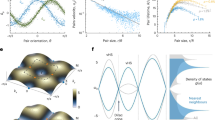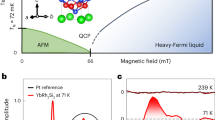Abstract
One of the most successful paradigms of many-body physics is the concept of quasiparticles: excitations in strongly interacting matter behaving like weakly interacting particles in free space. Quasiparticles in metals are very robust objects. Nevertheless, when a system’s ground state undergoes a qualitative change at a quantum critical point (QCP)1, the quasiparticles may disintegrate and give way to an exotic quantum-fluid state of matter. The nature of this breakdown is intensely debated2,3,4,5, because the emergent quantum fluid dominates material properties up to high temperatures and might even be related to the occurrence of superconductivity in some compounds6. Here we trace the dynamics of heavy-fermion quasiparticles in CeCu6−xAux and monitor their evolution towards the QCP in time-resolved experiments, supported by many-body calculations. A terahertz pulse disrupts the many-body heavy-fermion state. Under emission of a delayed, phase-coherent terahertz reflex the heavy-fermion state recovers, with a coherence time 100 times longer than typically associated with correlated metals7,8. The quasiparticle weight collapses towards the QCP, yet its formation temperature remains constant—phenomena believed to be mutually exclusive. Coexistence in the same experiment calls for revisions in our view on quantum criticality.
This is a preview of subscription content, access via your institution
Access options
Access Nature and 54 other Nature Portfolio journals
Get Nature+, our best-value online-access subscription
$29.99 / 30 days
cancel any time
Subscribe to this journal
Receive 12 print issues and online access
$259.00 per year
only $21.58 per issue
Buy this article
- Purchase on SpringerLink
- Instant access to full article PDF
Prices may be subject to local taxes which are calculated during checkout




Similar content being viewed by others
References
v. Löhneysen, H., Rosch, A., Vojta, M. & Wölfle, P. Fermi-liquid instabilities at magnetic quantum phase transitions. Rev. Mod. Phys. 79, 1015–1075 (2007).
Si, Q., Rabello, S., Ingersent, K. & Smith, J. L. Locally critical quantum phase transitions in strongly correlated metals. Nature 413, 804–808 (2001).
Coleman, P., Pépin, C., Si, Q. & Ramazashvili, R. How do Fermi liquids get heavy and die?. J. Phys.Condens. Mat. 13, R723–R738 (2001).
Senthil, T., Vojta, M. & Sachdev, S. Weak magnetism and non-Fermi liquids near heavy-fermion critical points. Phys. Rev. B 69, 035111 (2004).
Wölfle, P. & Abrahams, E. Quasiparticles beyond the Fermi liquid and heavy fermion criticality. Phys. Rev. B 84, 041101(R) (2011).
Kenzelmann, M. et al. Coupled superconducting and magnetic order in CeCoIn5. Science 321, 1652–1654 (2008).
Knoesel, E., Hotzel, A. & Wolf, M. Ultrafast dynamics of hot electrons and holes in copper: Excitation, energy relaxation, and transport effects. Phys. Rev. Lett. 57, 12812–12824 (1998).
Kummer, K. et al. Ultrafast quasiparticle dynamics in the heavy-fermion compound YbRh2Si2. Phys. Rev. B 86, 085139 (2012).
Wölfle, P. Quasiparticles in condensed matter systems. Rep. Prog. Phys. 81, 032501 (2018).
Ruderman, M. A. & Kittel, C. Indirect exchange coupling of nuclear magnetic moments by conduction electrons. Phys. Rev. 96, 99–102 (1954).
Kasuya, T. A theory of metallic ferromagnetism and antiferromagnetism on Zener’s model. Prog. Theor. Phys. 16, 45–57 (1956).
Yosida, K. Magnetic properties of Cu–Mn alloys. Phys. Rev. 106, 893–898 (1957).
Kondo, J. Resistance minimum in dilute magnetic alloys. Prog. Theor. Phys. 32, 37–49 (1964).
Hewson, A. C. The Kondo Problem to Heavy Fermions (Cambridge University Press, Cambridge, 1993).
Hertz, J. A. Quantum critical phenomena. Phys. Rev. B 14, 1165–1184 (1976).
Moriya, T. Spin Fluctuations in Itinerant Electron Magnetism. (Springer: Berlin, 1985).
Millis, A. Effect of a nonzero temperature on quantum critical points in itinerant fermion systems. Phys. Rev. B 48, 7183–7196 (1993).
Schröder, A. et al. Onset of antiferromagnetism in heavy-fermion metals. Nature 407, 351–355 (2000).
Stroka, B. et al. Crystal-field excitations in the heavy-fermion alloys CeCu6−xAux studied by specific heat and inelastic neutron scattering. Z. Phys. B 90, 155–160 (1993).
Ehm, D. et al. High-resolution photoemission study on low-T K Ce systems: Kondo resonance, crystal field structures, and their temperature dependence. Phys. Rev. B 76, 045117 (2007).
Klein, M. et al. Signature of quantum criticality in photoemission spectroscopy at elevated temperature. Phys. Rev. Lett. 101, 266404 (2008).
Doniach, S. The Kondo lattice and weak antiferromagnetism. Physica B 91, 231–234 (1977).
Marabelli, F. & Wachter, P. Temperature dependence of the optical conductivity of the heavy-fermion system CeCu6. Phys. Rev. B 42, 3307–3311 (1990).
v. Löhneysen, H. et al. Rare-earth intermetallic compounds at a magnetic instability. J. Alloy. Comp. 408–412, 9–15 (2006).
v. Löhneysen, H., Sieck, M., Stockert, O. & Waffenschmidt, M. Investigation of non-Fermi-liquid behavior in CeCu6−xAux. Physica B 223 & 224, 471–474 (1996).
Schröder, A., Lynn, J. W., Erwin, R. W., Loewenhaupt, M. & v. Löhneysen, H. Magnetic structure of the heavy fermion alloy CeCu5.5Au0.5. Physica B 199 & 200, 47–48 (1994).
Stockert, O., v. Löhneysen, H., Rosch, A., Pyka, N. & Loewenhaupt, M. Two-dimensional fluctuations at the quantum-critical point of CeCu6−xAux. Phys. Rev. Lett. 80, 5627–5630 (1998).
v. Löhneysen, H. et al. Heavy-fermion systems at the magnetic-nonmagnetic quantum phase transition. J. Mag. Mag. Mat. 177-181, 12–17 (1998).
Rosch, A., Schröder, A., Stockert, O. & v. Löhneysen, H. Mechanism for the non-Fermi-liquid behavior in CeCu6−xAux. Phys. Rev. Lett. 79, 159–162 (1997).
Nejati, A., Ballmann, K. & Kroha, J. Kondo destruction in RKKY-coupled Kondo lattice and multi-impurity systems. Phys. Rev. Lett. 118, 117204 (2017).
Aoki, H. et al. Nonequilibrium dynamical mean-field theory and its applications. Rev. Mod. Phys. 86, 779–837 (2014).
Kroha, J. & Wölfle, P. Fermi and non-Fermi liquid behavior in quantum impurity systems: Conserving slave boson theory. Acta Phys. Pol. B 29, 3781–3817 (1998).
Hettler, M. H., Kroha, J. & Hershfield, S. Non-equilibrium dynamics of the Anderson impurity model. Phys. Rev. Lett. 58, 5649–5664 (1998).
Acknowledgements
The authors are grateful for financial support by the SNSF via project No. 200021-14708 (M.F., C.W.) and by the DFG via SFB/TR 185 (J.K).
Author information
Authors and Affiliations
Contributions
All authors contributed to the discussion and interpretation of the experiment and to the completion of the manuscript. C.W. and S.P. performed the experiment and the data analysis. O.S. and H.v.L. provided the CeCu6−xAux samples. K.K. and C.K. provided YbRh2Si2 samples for reference experiments. J.K. performed the theoretical analysis. J.K. and M.F. initiated the experiment and supervised the work.
Corresponding authors
Ethics declarations
Competing interests
The authors declare no competing interests.
Additional information
Publisher’s note: Springer Nature remains neutral with regard to jurisdictional claims in published maps and institutional affiliations.
Supplementary information
Supplementary Information
3 Figures, 3 References
Rights and permissions
About this article
Cite this article
Wetli, C., Pal, S., Kroha, J. et al. Time-resolved collapse and revival of the Kondo state near a quantum phase transition. Nature Phys 14, 1103–1107 (2018). https://doi.org/10.1038/s41567-018-0228-3
Received:
Accepted:
Published:
Issue Date:
DOI: https://doi.org/10.1038/s41567-018-0228-3
This article is cited by
-
Terahertz control of many-body dynamics in quantum materials
Nature Reviews Materials (2023)
-
Critical slowing down near a magnetic quantum phase transition with fermionic breakdown
Nature Physics (2023)



